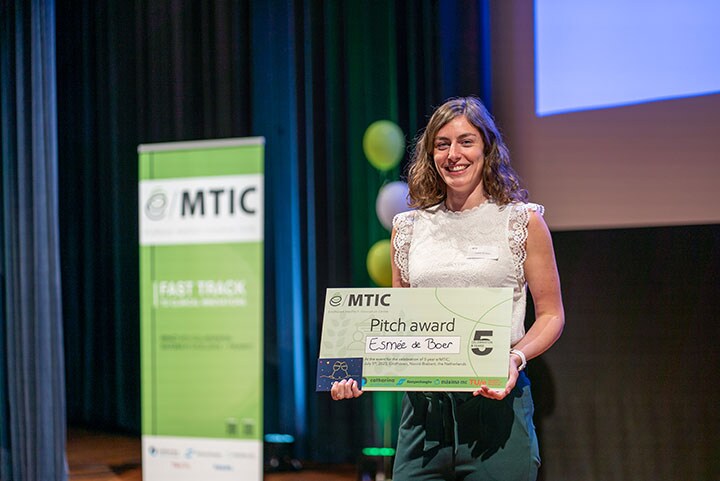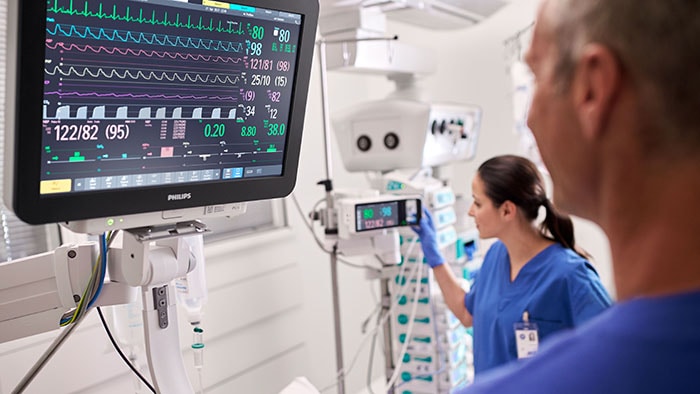Bloedstroom is een belangrijke parameter om te beoordelen of een patiënt niet verslechterd, bijvoorbeeld bij een patiënt op de intensive care. Om de bloedstroom goed vast te kunnen stellen, wordt in veel gevallen een invasieve methode gebruikt, met behulp van een arteriële katheter. Hoewel accuraat, is het voor de patiënt niet de prettigste methode en kan het zorgen voor complicaties.
Esmée de Boer, PhD studente aan de TU/e, onderzoekt vanuit welke hoek je met behulp van echografie de bloedstroom kan meten. Ze presenteerde de rotatie en kantel techniek tijdens de viering van het 5-jarig bestaan van e/MTIC, en dat leverde haar de Beste Pitch Award op.
Minimaal invasief monitoren
Hoe meet je de bloedstroom van een patiënt op de intensive care of na een operatie, zonder dat je een katheter hoeft te gebruiken? Dat was de fundamentele vraag waarmee Esmée de Boer in 2020 haar PhD aan de TU/e onderzoek aftrapte. Met een Master Technische Geneeskunde van de Technische Universiteit Twente op zak, reisde ze af naar Eindhoven om op te zoek te gaan naar een antwoord op die vraag. “Met een katheter kun je bloedstroom heel nauwkeurig meten, maar het zorgt in de praktijk ook voor complicaties.”
Samen met het Catharina Ziekenhuis en Philips test ze nu hoe ze echo kan gebruiken om de bloedstroom te meten. “Bloedstroom kun je vaststellen door de diameter van de halsslagader en de snelheid van het bloed te meten. Hierin is de hoek van de echoprobe ten opzichte van de halsslagader heel belangrijk. Wanneer je de halsslagader in de korte as meet, kun je namelijk wel de diameter, maar niet de snelheid van het bloed meten. Wanneer je daarentegen in de lange as meet, kan je zowel de diameter als de snelheid van het bloed meten, maar kan beweging van de patiënt of de zorgverlener het resultaat beïnvloeden.”
Hopelijk kunnen we mede door mijn onderzoek in de toekomst non-invasief, met behulp van echografie, de patiënt monitoren in het ziekenhuis.
Esmée de Boer
PhD Studente
Esmée toetste tijdens haar onderzoek een nieuwe hoek, waarbij de echoprobe wordt geroteerd en gekanteld. “Van de ellips doorsnede die je krijgt met deze methode, is het in theorie mogelijk om zowel de diameter van het vat als de snelheid van het bloed te meten. Dit moet nog gevalideerd worden bij patiënten in de kliniek, voordat we dit in de praktijk kunnen toepassen.”
Klinische toepassing
De klinische validatie waar Esmée zich in haar onderzoek op richt, is een kritische fase in het ontwikkelen van innovaties in de gezondheidszorg. "We hebben met dit onderzoek aangetoond dat de methode gebruikt kan worden om de diameter van de halsslagader vast te stellen,” aldus Esmée.
“De volgende stap is aan te tonen dat we deze methode ook kunnen gebruiken om de snelheid van het bloed te meten. Met deze twee variabelen kunnen we vervolgens de bloedstroom door de halsslagader vaststellen.” vertelt Esmée over de toekomstige toepasbaarheid van haar onderzoek. “Hopelijk kunnen we dan in de toekomst non-invasief, met behulp van echografie, de patiënt monitoren in het ziekenhuis.”

Beste Pitch Award
Esmée’s onderzoek wordt uitgevoerd binnen het samenwerkingsverband e/MTIC, het Eindhoven MedTech Innovation Center. Hierin werken de TU/e, het Catharina Ziekenhuis, Maxima Medisch Centrum (MMC), het Centrum voor Slaapgeneeskunde Kempenhaeghe en Philips samen aan diverse onderzoeken rondom cardiovasculaire, perinatale en slaap geneeskunde.
Op 5 juli vierde e/MTIC het 5-jarig bestaan, en kregen de PhD-studenten de kans hun onderzoek te presenteren aan de e/MTIC community en mee te dingen voor de titel Best Pitch Award. De jury beoordeelde in totaal 6 pitches, geselecteerd uit een totaal van 15 posters.
“Esmée wist met haar pitch duidelijk te maken wat de klinische toepasbaarheid en het toekomstperspectief van haar onderzoek is. Met dit onderzoek zijn we een stukje dichter bij het minimaal invasief monitoren van patiënten in het ziekenhuis, ” aldus Richard Kemkers, Innovation Program Manager Precision Diagnosis bij Philips en jurylid voor de Best Pitch Award.

Looking at a patient’s blood flow from a different angle: monitoring without using a catheter
Blood flow is an important parameter to monitor a patient’s condition, for example, for patients in intensive care. To determine blood flow, in many cases an invasive method is used, using an arterial catheter. Although accurate, it is not the most pleasant method for the patient and can cause complications.
Esmée de Boer, PhD student at TU/e, researches from which angle to best measure blood flow using ultrasound. She presented the rotation and tilt technique during e/MTIC's 5th anniversary celebration, which earned her the Best Pitch Award.
Minimally invasive monitoring
How do you measure a patient's blood flow in intensive care or after surgery without using a catheter? That was the fundamental question with which Esmée de Boer kicked off her PhD at TU/e research in 2020. With a Master's degree in Technical Medicine from the Technical University Twente in her pocket, she traveled to Eindhoven in search of an answer to that question. "With a catheter you can measure blood flow very accurately, but in practice it also causes complications."
Together with the Catharina Hospital and Philips, she is now testing how to use ultrasound to measure blood flow. "Blood flow can be determined by measuring the diameter of the carotid artery and the velocity of the blood. For this, the angle of the ultrasound probe in relation to the carotid artery is very important. This is because when you measure the carotid artery in the short axis, you can measure the diameter but not the speed of the blood. When you measure in the long axis, you can measure both the diameter and the velocity of the blood, but movement of the patient or the caregiver can affect the result."
Hopefully my research will contribute to monitoring patients in the hospital non-invasively, using ultrasound, in the future.
Esmée de Boer
PhD Studente
Esmée tested a new angle during her research, rotating and tilting the echo probe. "From the ellipse cross section that you get with this method, it is theoretically possible to measure both the diameter of the vessel and the velocity of the blood. This still needs to be validated in patients in the clinic before we can apply this in practice."
Clinical application
The clinical validation that Esmée focuses on in her research is a critical stage in developing healthcare innovations. "We have demonstrated with this study that the method can be used to determine the diameter of the carotid artery," Esmée said. "The next step is to demonstrate that we can also use this method to measure blood velocity. With these two variables, we can then determine the blood flow through the carotid artery." On the future applicability of her research, Esmée says, "Hopefully in the future we will then be able to non-invasively, using ultrasound, monitor the patient in the hospital."

Best Pitch Award
Esmée's research is conducted within the e/MTIC partnership, the Eindhoven MedTech Innovation Center. In this partnership, the TU/e, Catharina Hospital, Maxima Medisch Centrum (MMC), the Center for Sleep Medicine Kempenhaeghe and Philips work together on various research projects around cardiovascular, perinatal and sleep medicine.
On July 5, e/MTIC celebrated its 5th anniversary, and PhD students were given the opportunity to present their research to the e/MTIC community and compete for the title Best Pitch Award. The jury judged a total of 6 pitches, selected from a total of 15 posters.
"In her pitch, Esmée was able to make the clinical applicability and future perspective of her research very clear. With this research we are one step closer to minimally invasive monitoring of patients in the hospital, " said Richard Kemkers, Innovation Program Manager Precision Diagnosis at Philips and jury member for the Best Pitch Award.












